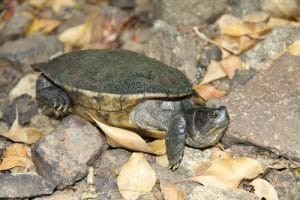Trachemys nebulosa (Baja California slider)
Home > Turtle Database > Trachemys nebulosa (Baja California slider)

The Baja California slider, Trachemys nebulosa, is a freshwater turtle found in northwestern Mexico. It looks similar to the more common red-eared slider but has its own distinct features and a limited native range. This species is rarely seen in the pet trade and faces growing threats in the wild.
Native Turtle Species Map – Find Turtles by Region
Scientific Classification
Kingdom: Animalia
Phylum: Chordata
Class: Reptilia
Order: Testudines
Family: Emydidae
Genus: Trachemys
Species: Trachemys nebulosa
Common Names
Baja California slider
Nebulous slider
This Hilarious Turtle Book Might Know Your Pet Better Than You Do
Let’s be real—most turtle care guides feel like reading a textbook written by a sleep-deprived zookeeper.
This one’s not that.
Told from the snarky point of view of a grumpy, judgmental turtle, 21 Turtle Truths You’ll Never Read in a Care Guide is packed with sarcasm, sass, and surprisingly useful insights.
And hey—you don’t have to commit to the whole thing just yet.
Grab 2 free truths from the ebook and get a taste of what your turtle really thinks about your setup, your food choices, and that weird plastic palm tree.
It’s funny, it’s honest, and if you’ve ever owned a turtle who glares at you like you’re the problem—you’ll feel seen.
Identification
Description
The Baja California slider has a green to olive carapace with subtle yellow striping. Its plastron is yellow with dark markings. The skin is dark green with yellow stripes running along the head, neck, and limbs. Unlike the red-eared slider, it usually lacks the distinct red mark behind the eyes.
Sexual Dimorphism
Males are smaller than females and have longer front claws and longer, thicker tails. Females grow larger and have shorter claws and tails.
Check more turtles from the Trachemys genus
Native Origin and Distribution
Geographical Range
This species is native to the Baja California Peninsula, particularly in freshwater bodies of the Sierra de San Pedro Mártir and parts of northwestern Mexico. It is not found outside this region naturally.
Preferred Habitat
Baja California sliders live in freshwater environments like rivers, ponds, and lakes. They prefer areas with slow-moving or still water, lots of aquatic vegetation, and sunny spots for basking.
Behavior
Feeding Habits
They are omnivores, eating aquatic plants, insects, snails, and small fish. Young sliders eat more protein, while adults eat more plants.
Predators
Predators include raccoons, birds, and large fish. Hatchlings are especially vulnerable due to their small size.
Reproduction
Breeding Season
Mating usually happens in spring and early summer, when water temperatures rise.
Reproductive Method
Females lay eggs in sandy or soft soil near water. One clutch can contain several eggs, and the female may lay multiple clutches in a season.
Conservation
Extinction Status
Listed as not evaluated.
Threats
Main threats include habitat loss, water pollution, and competition or hybridization with introduced red-eared sliders.
Conservation Measures
Local efforts focus on protecting natural water sources and managing invasive species. Breeding programs are limited due to lack of awareness.
Economic Importance
This turtle has limited economic value. It’s not common in the pet trade and isn’t widely used in research or food. Its presence helps control insect populations in its native ecosystem.
Interesting Facts
Unlike its red-eared cousin, the Baja California slider is quite rare outside its home range.
It has a shy nature and is more reclusive, making it harder to spot in the wild.
This turtle is one of the few native turtles in the Baja California Peninsula, making it ecologically important.

About Author
Muntaseer Rahman started keeping pet turtles back in 2013. He also owns the largest Turtle & Tortoise Facebook community in Bangladesh. These days he is mostly active on Facebook.














